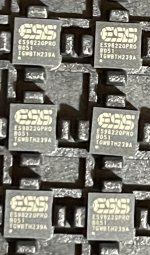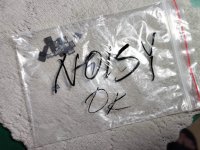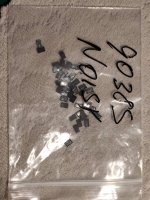My experience with those circuits in the Shibasoku suggests otherwise. Both opamps are critical. The buffer driving the bottom of the T extremely so. And the input impedance is not high which can impact measurements of some devices. You can get residuals of -135 dB on the harmonics with a great deal of care.
B&K made a tunable passive notch with some magic to correct the harmonics to a constant level. They never published the circuit and I have not had the patience to reverse engineer it. In the corrected mode there is a 20 dB insertion loss so its of limited use.
B&K made a tunable passive notch with some magic to correct the harmonics to a constant level. They never published the circuit and I have not had the patience to reverse engineer it. In the corrected mode there is a 20 dB insertion loss so its of limited use.
Well, I see you are not willing to disclose anything serious about the “magic” of this balanced analog notch filter with not more than 0.6dB attenuation of the H2. Apparently it is not a passive filter, so then there’s the legitimate question how do you build an active filter at these distortion levels., in particular if positive feedback is used.
Coincidentally, last few weeks I have been looking at a fully balanced gyrator circuits for Pro Audio applications. This can certainly be applied to a pseudo
'floating' balanced notch filter application.
I believe, after playing for quite some time on Ltspice, that the distortion will be most apparent at notch frequency. This could have some weird and
possible cancellation effects. Having said that, the gyrators use simple OPA buffers so most likely CM distortion will dominate over transfer. Since its
balanced CM dist will likely cancel.
So overall it should be possible to make a fairly simple fully balanced / floating VLD notch filter with some VHQ OPA's such as OPA1656 etc.
I guess the other issue is noise.
TCD
Yeah, the noise is another goal for such a notch filter. I tried to find a balance between noise and distortions performance, if the task was in maximal harmonics resolution, I wouldn't go with so low impedance of the filter(100/200nF 1600/800ohm). OPA1656, and SGM8261 aka RT6863 as input buffer produce SNR about 134db for 0db(10Vrms input max), or 132.6db for +6db(5Vrms input max) i.e. 2/1.2uVrms unweighted.
Finally; the datasheet is indeed as bad and incomplete as one could expect from ESS. I suspect there are a few levels of information disclosure and I got to the basic one.
Now let's see what these fresh out the foundry chips can do, and how they compare with the industrial grade ADCs. I'll keep this thread updated.
Now let's see what these fresh out the foundry chips can do, and how they compare with the industrial grade ADCs. I'll keep this thread updated.
Attachments
I got 1005pcs + 3 samples before, and already see a noticeable inconsistency of some chips. I remember, seems 5th element told me in PM that he got some FFT spikes on the noise floor of his ES9822. I had no problem with the first 3 samples but now I've got some noise-like burst up to -150db as well. I checked all stuff around but it is for sure ADC chip's artifact because it floats across the frequency vs ES9822 temperature. Interesting, that I have such spikes only with very good ES9822 i.e. 125/128db(A) SNR, 124/127db(A) or a bit worse have no such spikes at all. The noise itself is also better when the chip is warmer than 45C, I had the idea to apply the thermal pad under the PCB to keep it colder but now decide to forget about that - hotter is better.
If they are inconsistent, yet can send perfect samples, not a vendor I would trust. Plus there are the issues with data sheets I have been hearing about.
Sounds like you have to do 100% incoming QC with these people. Then there are the conditions for acceptance and return policy to worry about. I wouldn't deal with them. From what you are saying, I would expect failures in quality down the road once the chips are installed and in service for some time. So something that passed your inspection before delivery to your customer may degrade in performance and cost your reputation through no fault of your own. Is that worth it?
-Chris
Sounds like you have to do 100% incoming QC with these people. Then there are the conditions for acceptance and return policy to worry about. I wouldn't deal with them. From what you are saying, I would expect failures in quality down the road once the chips are installed and in service for some time. So something that passed your inspection before delivery to your customer may degrade in performance and cost your reputation through no fault of your own. Is that worth it?
-Chris
I got 1005pcs + 3 samples before, and already see a noticeable inconsistency of some chips. I remember, seems 5th element told me in PM that he got some FFT spikes on the noise floor of his ES9822. I had no problem with the first 3 samples but now I've got some noise-like burst up to -150db as well. I checked all stuff around but it is for sure ADC chip's artifact because it floats across the frequency vs ES9822 temperature. Interesting, that I have such spikes only with very good ES9822 i.e. 125/128db(A) SNR, 124/127db(A) or a bit worse have no such spikes at all. The noise itself is also better when the chip is warmer than 45C, I had the idea to apply the thermal pad under the PCB to keep it colder but now decide to forget about that - hotter is better.
Sounds like the ADC version of the ESS hump.
So something that passed your inspection before delivery to your customer may degrade in performance and cost your reputation through no fault of your own. Is that worth it?
Yes, if there are no other options on the market. With or without spurious it is still the best ADC available today, and nothing better seems to be on the white board (I hope I am wrong).
Hi syn08,
That's a tough call.
What do you do, reduce your stated performance specs so that degraded units still pass? That would be the honest thing to do. Then you look at the competing ADCs to see if their performance is better than your more realistic spec turns out to be. Decide what part to use based on that.
With what I have heard so far, I would be concerned with long term performance. There are obviously production / yield problems that they have decided to pass anyway. That's what I do not like or trust about that company.
-Chris
That's a tough call.
What do you do, reduce your stated performance specs so that degraded units still pass? That would be the honest thing to do. Then you look at the competing ADCs to see if their performance is better than your more realistic spec turns out to be. Decide what part to use based on that.
With what I have heard so far, I would be concerned with long term performance. There are obviously production / yield problems that they have decided to pass anyway. That's what I do not like or trust about that company.
-Chris
If they are inconsistent, yet can send perfect samples, not a vendor I would trust. Plus there are the issues with data sheets I have been hearing about.
Sounds like you have to do 100% incoming QC with these people. Then there are the conditions for acceptance and return policy to worry about. I wouldn't deal with them. From what you are saying, I would expect failures in quality down the road once the chips are installed and in service for some time. So something that passed your inspection before delivery to your customer may degrade in performance and cost your reputation through no fault of your own. Is that worth it?
-Chris
I producing DAC+HPA ES9038Q2M based, we call that #9038D. I do calibrate every one unit before sell, and print the result of testing on the DACs case(DR 125db(A)+/-2db $100, <123db(A) $70). Before I did replace about 4% of ES8938Q2M due to DR worse >3db than the average unit provides. By that way I have collected a bag with 100pcs+ of 9038q2m, I asked ESS about how to deal with that situation, they don't care. So not a big deal to calibrate each unit, anyway I have to compensate 2,3, and 5th harmonics of the ADC. The moving noise spike doesn't affect THD+N of SNR/DR at all, and the best units has -123db residual THD+N, that way lover than AP SYS2*** and near to APx555.
As long as you are okay with that and it makes sense for you. I just get the impression that the issues are calculated. They know they have issues but do not seem to be doing anything to improve the situation.
Also, as long as the parts meet their spec, but you already know a reasonable percentage don't. I do applaud you for removing those parts from your supply instead of selling them to customers. Too bad the extra testing is required.
-Chris
Also, as long as the parts meet their spec, but you already know a reasonable percentage don't. I do applaud you for removing those parts from your supply instead of selling them to customers. Too bad the extra testing is required.
-Chris
not sure if I understand what kinda integration and the same time input cap you mean? I didn't see 9102.pdf, 9822 has quite a typical ADC frontend - 36ohm, 100p to GND, and 1n between the inputs.Does ES9822 have the big external integration capacitor on the inputs like ES9102?
As long as you are okay with that and it makes sense for you. I just get the impression that the issues are calculated. They know they have issues but do not seem to be doing anything to improve the situation.
Also, as long as the parts meet their spec, but you already know a reasonable percentage don't. I do applaud you for removing those parts from your supply instead of selling them to customers. Too bad the extra testing is required.
-Chris
I do not throw out ES9038Q2M anymore, as I said, I just print the test result on the case and offer a "bad" unit cheaper. You know, when you ordering 1000pcs SMT soldering, next assembling better to do that the same week. If I go to test and replace bad chips for a good one, I'll spend a lot of time, so the supplier doesn't like to have a time gap.
Attachments
Not sure if you guys saw this, appears to be public info (design files).
ES9842QPRO Sabre 4CH ADC Evaluation Board - Ismosys
ES9842QPRO Sabre 4CH ADC Evaluation Board - Ismosys
Hi IVX,
-Chris
That's still being honest about it. I can respect that approach.I just print the test result on the case and offer a "bad" unit cheaper.
-Chris
Not sure if you guys saw this, appears to be public info (design files).
ES9842QPRO Sabre 4CH ADC Evaluation Board - Ismosys
their PCB layout is awfully designed in my opinion, just like a schoolboy made.
The noise itself is also better when the chip is warmer than 45C, I had the idea to apply the thermal pad under the PCB to keep it colder but now decide to forget about that - hotter is better.
Warmer mask the noise spurs? I'm at a loss of a noise process that gets *better* with heat. Certainly something like popcorn noise will be more apparent when the rest of the background is lower.
Something to play with in the ES98X2 QFN EVB 1v2v1.pdf, a small dc offset at adc input might be worth a look. See r97/r18(nf).
A relevant ESS PDF without signing your life? Where is that?
- Home
- Design & Build
- Equipment & Tools
- ADCs and DACs for audio instrumentation applications


